Chapter 2: Influences on Learning: Student Differences and Similarities
“He is just so lazy – sits there and refuses to do any work. And his parents are no help – they never return phone calls or emails. Why bother?”
This is an actual statement by a teacher frustrated with a fourth grader in her classroom. What this teacher did not know was the context in which the student was living. He was homeless and living out of his mother’s car. His mother couldn’t pay her cell phone bill, so had no way of receiving phone calls or emails. The teacher failed to realize what else could be contributing to his “laziness”: hunger, fear, lack of adequate care, and a parent unavailable to him with her own struggle to survive.
You will hear this repeated in this text again and again: in order to teach our students, we have to know them. Multiple influences affect our students and their environments.
In this chapter, we will focus on how student differences and similarities influence students’ experiences in our classrooms. First, we will investigate how different systems influence learning. Next, we will explore selected theoretical perspectives on development. Finally, we will consider how additional similarities and differences can impact learning, specifically for English Learners (ELs) and students with disabilities.
Chapter Outline
- Systems that Influence Student Learning
- Theoretical Perspectives on Development
- Additional Similarities and Differences That Can Impact Learning
- Conclusion
Systems that Influence Student Learning
As humans grow and develop, there are many different systems that influence this development. Think about systems as interrelated parts of a whole, just like the solar system is made up of planets and other celestial objects. Three theories that consider varying impacts on student learning are Bronfenbrenner’s ecological systems theory, Maslow’s hierarchy of needs, and Gardner’s theory of multiple intelligences.
Bronfenbrenner’s Ecological Systems Theory
Bronfenbrenner’s ecological systems theory (see Figure 2.1) is a theory of child development which outlines five levels of influence from a student’s environment (Bronfenbrenner, 1989).
- In the center is the individual–in this case, the student. Features of the individual include age, gender (including pronouns), sexual orientation, race, religion, and ethnicity.
- The microsystem is the next circle. This includes the student’s family structure, school, peers, the church (if the student goes to church) and any other context with which the student interacts on a more direct level.
- The mesosystem is where these microsystems make connections with one another, such as between a teacher and a family member.
- The exosystem is the larger social system with which the student may not interact directly, but which influences their environment. In the case of a student, this could be social services that are provided to the family.
- The macrosystem incorporates the global influences on the student’s environment and development. One example of the macrosystem is cultural norms, which impact a student’s environment on a large scale.
Figure 2.1: Bronfenbrenner’s Ecological Systems Theory
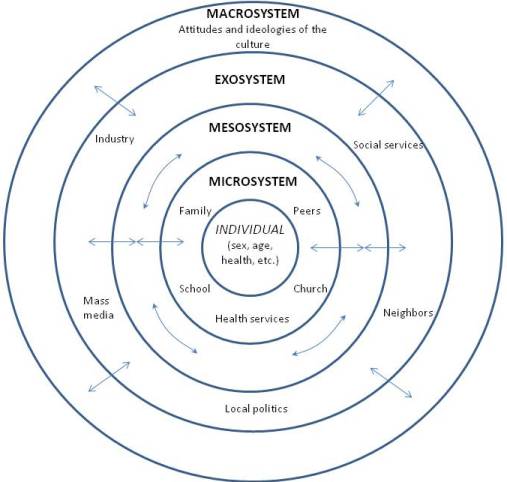
Maslow’s Hierarchy of Needs
Another way to conceptualize other influences on student learning is through need systems within Maslow’s hierarchy of needs (see Figure 2.2). Maslow theorized that people are motivated by a succession of hierarchical needs (McLeod, 2020). Originally, Maslow discussed five levels of needs shaped in the form of a pyramid. He later adjusted the pyramid to include eight levels of needs, incorporating need for knowledge and understanding, aesthetic needs, and transcendence. Figure 2.2 depicts these eight needs in hierarchical order. The first four levels are deficiency needs, and the upper four are growth needs. The first four are essential to a student’s well being, and they build on each other. These deficiency needs must be satisfied before a person can move on to the growth needs. Moving to the growth needs is essential for learning to truly occur. Now we will examine each of the elements within Maslow’s hierarchy of needs in more depth.
Figure 2.2: Maslow’s Hierarchy of Needs
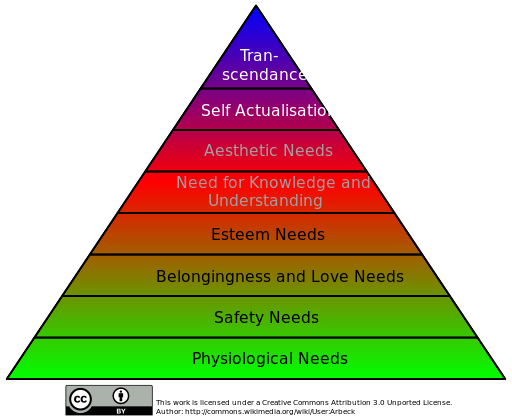
Of the eight levels, the first is physiological needs. These needs include food, water, and shelter. In this case, do students have a home where they are properly nourished? If not, students who are not attending to their work may be hungry, not just daydreaming. This is the reason why free and reduced breakfast and lunch programs are so essential in schools.
Safety and security needs are the second level of the pyramid. Students need to feel that they are not in harm’s way. Though schools are responsible for maintaining safe environments for students, classrooms also need to feel safe and secure. This requires classroom rules that all students follow, including protecting students from bullying and threatening behavior. There are effective and less effective ways to structure a classroom so that it is safe for all students, which you’ll learn more about in Chapter 7.
The third level of Maslow’s hierarchy is love and belonging. In schools, these needs are met primarily through positive relationships with teachers and peers, and people with whom students regularly interact. Feelings of acceptance are necessary here, and teachers can play a huge role in creating these feelings for students. It is critical that teachers are non-judgmental towards their students. It does not matter how you, as a teacher, may feel about a student’s lifestyle choices, beliefs, political views or family structures; it matters how a student perceives you as someone who accepts them, no matter what. For example, a student who misbehaves is communicating something to you. To address this, we must not judge the student, but rather the behavior.
The fourth and final level in the area of deficiency needs is esteem needs: self-worth and self-esteem. Students must have experiences in schools and classrooms that lead them to feel positive about themselves. Self-esteem is what students think and feel about themselves, and it contributes to their confidence. Self-worth is students knowing that they are valuable and lovable. One critical issue in this level of the pyramid is teachers ensuring that their students do not develop learned helplessness. Learned helplessness has to do with students’ locus of control. If a student thinks that doing well in school is something out of their control, then they feel that nothing they do will affect their success. If teachers ensure that students experience success, then students will feel that hard work does, in fact, pay off. This can also be referred to as students having fixed mindsets or growth mindsets (Dweck, 2006). Students who develop a fixed mindset “accept the premise that [they] are born smart or not smart–able or not able” (Sousa & Tomlinson, 2018, p. 29). By contrast, students who develop a growth mindset “believe that while genetics may sketch out a starting point in [their] development, it is [their] own determination and persistence–in combination with persistent and determined support–that predict success” (Sousa & Tomlinson, 2018, p. 29).
CRITICAL LENS: CRITIQUES OF MINDSETS
Despite the popularity of the growth mindset movement, there are some critiques of this theory. First, some of Dweck’s original studies came into question for their design and inconsistent results when other people tried to replicate them (i.e., Li & Bates, 2019). In research, it is important that if another person replicates the same study design, they find the same results; if they don’t, it calls into question what the original study did and found. Sisk et al. (2018) conducted two meta-analyses into many studies surrounding growth mindset and found weak effects overall (contrary to the dramatic benefits usually claimed when using growth mindset), though some benefits did exist of doing mindset work with lower-income students or students who struggle academically. Dweck herself[1] admits that the theory is complex and misapplied, specifically when teachers simply teach growth vs. fixed mindset without changing other instructional and environmental supports, or when teachers think the growth mindset is developed simply by praising students’ efforts.
Following the four deficiency needs, next in Maslow’s hierarchy of needs are growth needs. Once students reach growth needs, they are ready for true, meaningful learning. The fifth element, the need to know and understand, can also be referred to as cognitive needs. It is our job as educators to motivate students to want to know and understand the world around them. In order to do this, we must be sure we are providing our students with questions that move them to higher-order thinking skills. An instructional model that is well-developed and utilized in many classrooms is Bloom’s Taxonomy. It can be used to classify learning objectives, and it is a way to encourage students to think more deeply about content and motivate them to want to know more. This model will be discussed in more detail in Chapter 6.
The sixth level of Maslow’s hierarchy of needs is aesthetic needs. At this level, we can learn to appreciate the beauty of the natural world. When we are focused on deficiency needs in the lower levels of Maslow’s theory, it is more difficult to see the beauty in our environment and surroundings. In education, students need to be exposed to the beauty that is reflected in the arts: music, visual arts and theatre. Most schools separate these into distinct periods or blocks; however, it is essential that arts are also integrated into the curriculum. Additionally, students should be exposed to arts outside of Western art. As we have already discussed, students come from a variety of cultures and backgrounds; therefore, they need to encounter art forms that include representations of all cultures, particularly their own.
Self-actualization is the seventh need on the pyramid and is another growth need. Maslow indicated that this happens as we age. It is our intrinsic need to make the most of our lives and reach our full potential. A way of thinking about this is to consider what we think of our ideal selves–or, for young people, how they see ourselves or what they see ourselves having achieved and broadly experienced as we get to later stages in life.
Finally, transcendence needs are the highest on Maslow’s hierarchy. Maslow (1971) stated, “transcendence refers to the very highest levels of human consciousness, behaving and relating, as ends rather than means, to oneself, to significant others, to human beings in general, to other species, to nature, and to the cosmos” (p. 269). Though most of us in K-12 schools will not experience students at this level, it is important to note that this is the goal in life, according to Maslow.
Critical Lens: Origins of Theories
Sometimes we hold theories as universal truths without stopping to consider the context in which they were made. For example, Bridgman, Cummings, and Ballard (2019) recently investigated the origin of Maslow’s theory and discovered that he himself never created the well-known pyramid model to represent the hierarchy of needs. Furthermore, there are concerns that Maslow appropriated his theory from the Siksika (Blackfoot) Nation. Dr. Cindy Blackstock (Gitksan First Nation member, as cited in Michel, 2014) explains the Blackfoot belief involves a tipi with three levels: self-actualization at the base; community actualization in the middle; and cultural perpetuity at the top. Maslow visited the Siksika Nation in 1938 and published his theory in 1943. Bray (2019) explains more about Maslow’s hierarchy of needs and its alignment with the Siksika Nation. You should be informed of Maslow’s hierarchy, but you should also be aware that critiques of this theory exist.
Gardner’s Theory of Multiple Intelligences
Teachers need to determine students’ areas of strength and need to allow students to work and grow in those areas. One approach to doing this is to determine students’ strengths in different intelligence areas. Theorist Howard Gardner (2004, 2006) initially proposed eight multiple intelligences (see Figure 2.3), but he later added two more areas: existential and moral intelligence. Though there is little educational research evidence to support instructing students in these eight intelligences (for example, you should not plan a lesson eight different ways to address all eight intelligences in one lesson!), Gardner’s goal was to ensure that teachers did not just focus on verbal and mathematical intelligences in their teaching, which are two very common foci of instruction in schools.
Figure 2.3: Gardner’s Multiple Intelligences
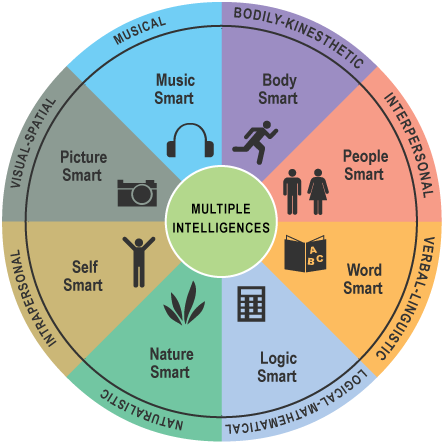
Similarly, while we often can hear reference to learning styles (often including visual, auditory, reading/writing, and kinesthetic, or VARK), they have no research-based support. Instead, “people’s approaches to learning can, do, and should vary with context…Rather than assessing and labeling students as particular kinds of learners and planning accordingly, a wise teacher will do the following:
- Offer students options for learning and expressing learning
- Help them reflect on strategies for mastering and using critical content
- Guide them in knowing when to modify an approach to learning when it proves to be inefficient or ineffective in achieving the student’s goals” (Sousa & Tomlinson, 2018, p. 161-162).
Learn more about the myth of learning styles in the video below.
Theoretical Perspectives on Development
While all human beings are unique and grow, learn, and change at different rates and in different ways, there are some common trends of development that impact the trajectories our students follow. Four common theories of development are Piaget’s cognitive developmental theory, Vygotsky’s sociocultural theory, Erikson’s psychosocial theory, and information processing theory.
Cognitive Developmental Theory: Piaget
Cognitive developmental theorists such as Jean Piaget posit that we move from birth to adulthood in predictable stages (Huitt & Hummel, 2003). These theorists argue these stages of development do not vary and are distinct from one other. While rates of progress vary by child, the sequence is the same and skipping stages is impossible. Therefore, progression through stages is essentially the same for each child.
In 1936, Piaget proposed four stages of cognitive development for children:
- the sensorimotor stage, which ranges from birth to age two;
- the preoperational stage, ranging from age two through age six or seven;
- the concrete operational stage, ranging from age six or seven through age 11 or 12;
- and the formal operational stage, ranging from age 11 or 12 through adulthood.
Piaget argued that key abilities are acquired at each stage. We will now look at each stage in depth, along with videos demonstrating these abilities in action.
In the sensorimotor stage, little children learn about their surroundings through their senses. In addition, the idea of object permanence is emphasized. This is a child’s realization that things continue to exist even if they are not in view. An example is when parents play peek-a-boo with their infants. The child sees that the parent or caregiver is actually gone when the parent’s or caregiver’s hands are in front of their faces. The video below demonstrates the idea of object permanence.
In the preoperational stage, children develop language, imagination, and memory, working toward symbolic thought. One of the key ideas is the principle of conservation, meaning that specific properties of objects remain the same even if other properties change. The notion of centration is critical here in that children only pay attention to one aspect of a situation. An example is filling a shallow round container with water, then pouring the same amount of water into a skinny container. The child in the preoperational stage will say that there is now more water in the skinny container, even though no additional liquid was added. The video below demonstrates the principle of conservation.
Additionally, in the preoperational stage, Piaget suggested that children have egocentric thinking, meaning that they lack the ability to see situations from another person’s point of view. The video below demonstrates the idea of egocentrism.
In the concrete operational stage, children begin to think more logically and abstractly and can now master the idea of conservation as they work toward operational thought. Children in this stage are less egocentric than before. Key developments in this stage include the notions of reversibility, which is defined as the ability to change direction in linear thinking to return to starting point, and transitivity, which is the ability to infer relationships between two objects based upon objects’ relation to a third object in serial order. The video below demonstrates the ideas of reversibility and transitivity.
Finally, the formal operational stage continues through adulthood. This is when we can better reason and understand hypothetical situations as we develop abstract thought. Key ideas include metacognition, which is the ability to monitor and think about your own thinking; and the ability to compare abstract relationships, such as to generate laws, principles, or theories. The video below demonstrates the idea of hypothetical thinking, where we see how a boy in the concrete operational stage and a woman in the formal operations stage respond to the same scenario.
In addition to his four stages of cognitive development for children, Piaget also discussed how we add new information to our existing understandings. Key terms in his conceptualization of cognitive constructivism include schema, assimilation, accommodation, disequilibrium, and equilibrium. Schema refers to the ways in which we organize information as we confront new ideas. For example, children learn what a wallet is and that it generally contains money. Next they learn that a wallet can be carried in various places, i.e. a pocket or a purse. The child is making a connection now between the idea of a wallet and the category of places where it can be carried. The child’s schema is developing as ideas begin to interconnect and form what we can call a blueprint of concepts and their connections.
In order to develop schema, Piaget would have said that children (and all of us) need to experience disequilibrium. Children are in a state of equilibrium as they go about in the world. As they encounter a new concept to add to their schema, they experience disequilibrium where they need to process how this new information fits into their schema. They do this in two ways: assimilation and accommodation. Assimilation uses existing schema to interpret new situations. Accommodation involves changing schema to accommodate new schema and return to a state of equilibrium. Let’s try an example. A child knows that banging a fork on a table makes noise, and the fork does not break. That child and concept are in a state of equilibrium, with the existing schema of knowing banging things on tables does not break the item. The next day, a parent gives the child a sippy cup. The child bangs it on the table and it also does not break, so the child assimilates this new object into their existing understanding that banging items on tables does not break the item. One day, a parent gives the child an egg. The child proceeds to bang it on the table, but what happens? The egg breaks, sending the child’s schema–everything that they bang on the table remains unbroken–into a state of disequilibrium. That child must accommodate that new information into their schema. Once this new information is accommodated, the child can once again move into equilibrium. The video below explains the idea of schema, assimilation and accommodation.
Sociocultural Theory: Vygotsky
Whereas Piaget viewed learning in specific stages where children engage in cognitive constructivism (Huitt & Hummel, 2003), thus emphasizing the role of the individual in learning, Lev Vygotsky viewed learning as socially constructed (Vygotsky, 1986). Vygotsky was a Russian psychologist in the 1920s and 1930s, but his work was not known to the Western world until the 1970s. He emphasized the role that other people have in an individual’s construction of knowledge, known as social constructivism. He realized that we learned more with other people than we learned all by ourselves.
One of the major tenets in Vygotsky’s theory of learning (Vygotsky, 1986) is the zone of proximal development. As shown in Figure 2.4, the zone of proximal development (ZPD) is the difference between what a learner can do without help and what they can do with help.
Figure 2.4: Vygotsky’s Zone of Proximal Development (ZPD)
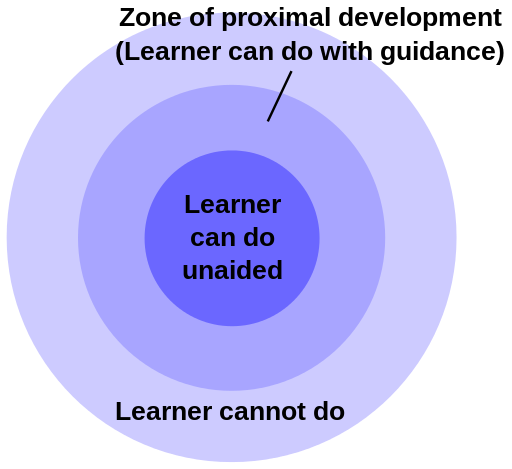
Vygotsky’s often-quoted definition of zone of proximal development says ZPD is “the distance between the actual developmental level as determined by independent problem solving and the level of potential development as determined through problem solving under adult guidance, or in collaboration with more capable peers” (Vygotsky, 1978, p. 86). The concept of scaffolding is closely related to the ZPD. Scaffolding is a process through which a teacher or more competent peer gives aid to the student in her/his ZPD as necessary, and tapers off this aid as it becomes unnecessary, much as a scaffold is removed from a building during construction. While we often think of a teacher as the more “expert other” in ZPD, this individual does not have to be a teacher. In fact, sometimes our own students are the more “expert other” in certain areas. Vygotsky’s sociocultural theory emphasizes that we can learn more with and through each other.
Psychosocial Theory: Erikson
According to Erik Erikson (1963), as people grow (or students, in our case), they face a series of what he called psychological crises that shape our students’ personalities. Each crisis focuses on a particular aspect of personality and involves the person’s relationship with other people, specifically parents, caregivers, other family members, classmates, peers, and partners. Figure 2.5 depicts the series of psychological crises that Erickson identified: trust vs. mistrust; autonomy vs. shame and doubt; initiative vs. guilt; industry vs. inferiority; identity vs. role confusion; intimacy vs. isolation; generativity vs. stagnation; and ego integrity vs. despair.
Figure 2.5: Erikson’s Psychological Crises
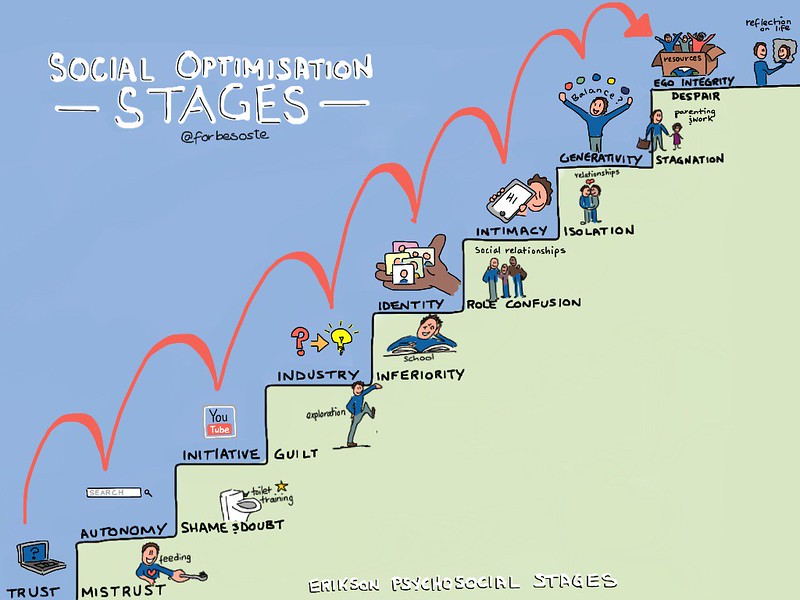
The video below details Erikson’s proposed stages.
The essential takeaway from Erikson’s theory (Erikson, 1963) for us as teachers is that our students could have experienced any number of these “unresolved” stages, which can mirror certain behaviors they exhibit in the classroom. Students can often show feelings of doubt, mistrust, and inferiority at the younger grades. In older grades, we can see more issues of students’ sense of identity playing out in terms of peer interactions and sometimes feelings of isolation. It is important to keep these issues in mind as teachers, but we also do not want to be so strict in the theory’s application that we overgeneralize our students’ actions.
Information Processing Theory
In terms of how our students process information that we are teaching in class, we have to look at how theorists, specifically cognitive psychologists, have looked at how the brain functions when it is processing information. According to the information processing theory (Atkinson & Shiffrin, 1977), we have the ability to think and problem solve using three basic mental processes:
- attending to sensory input in the sensory register;
- encoding the attended information into short-term or working memory; and
- retrieving information from long-term memory.
Information processing theory explains why teaching something one time doesn’t result in all students remembering it. You may hear teachers say, “I taught this content last week, and my students don’t remember a thing.” That is because the information hasn’t been processed, or encoded, into long-term memory. The best way to help students store new information in long-term memory is to use strategies such as rehearsal and mnemonics, a memory technique to help your brain better encode and recall important information.
The following video provides an explanation of the information processing model.
CRITICAL LENS: CONTEXT MATTERS
As we examine these four theories, it is also important to analyze the context of this work: these theorists and researchers all identified as White, often working with individuals close to them to conduct research (for example, Piaget studied his own children). As you learned in Chapter 1, we all absorb certain beliefs and social norms from our communities, so knowing that these theories came from communities that represented fairly limited diversity is important.
Additional Similarities and Differences that Can Impact Learning
In addition to the influences on student learning we have already explored in this chapter, there are two additional sub-groups of students you will work with in your future classroom that have very unique learning strengths and needs: English learners (ELs) and students with disabilities.
English Learners
English Learners (ELs) are the fastest-growing group of students in U.S. schools: in 2018, they comprised 10.2% of learners, totaling over 5 million students (NCES, 2020). Most teachers can now expect to have ELs in their classrooms at some point in their teaching careers. The majority of our ELs know Spanish as their first language, but there are many different languages that ELs know as their first languages, including Korean, Arabic, Urdu, Vietnamese, Japanese, French, as well as less common regional languages, such as those from various African countries.
STOP & INVESTIGATE
Take a moment to determine the most common language of ELs in your state and local school district. A good resource to use is your state department of education statistics. For example, the Virginia Department of Education houses this information on its EL website[2]. When you looked at your own state, is what you found surprising? Expected? What does this mean for you as a teacher?
English Learners have gone by many acronyms over the years, and the most accepted and widely used term right now is English Learners. When these students were first identified/categorized as a group in U.S. schools, they were termed Limited English Proficient (LEP) students. The federal government and most states in their regulations still refer to ELs as LEP students. However, the term LEP suggests a deficit view of students learning English. It was argued, rightly, that “limited” focused on what students lacked, rather than looking at students learning English as already coming with knowledge of their first language. Terms that followed included English as a Second Language (ESL) students, with a criticism of this term being that students who are English Learners sometimes already know two or three, or more, languages prior to learning English. Another term that is often used to describe English Learners is English Language Learners (ELLs). This is considered an acceptable term for describing students who are learning English in schools. Additional acceptable terms used to describe students learning English in schools are multilingual learners, bilingual learners, and language learners. Regardless of the words used, all of these terms refer to students who are learning English in schools who are also proficient in a first language, or L1, which is also referred to as the home language or mother tongue. Table 2.1 breaks down preferred and less-preferred language and the reasons for each.
Table 2.1: Preferred and Less Preferred Language and Rationales
| Preferred Language & Rationale | Less Preferred Language & Rationale |
|
|
Programs that service ELs in schools are most often referred to as ESL programs (English as a Second Language programs) or ESOL programs (English for Speakers of Other Languages programs). These programs are generally taught by licensed ESL teachers who specialize in language learning. Most ESL/ESOL programs are “pull-out” programs where small groups of students work with the ESL teacher during certain parts of the day, depending on student and ESL teacher schedules. In these pull-out programs, ESL teachers are working with students on their English skills, while at the same time often assisting classroom teachers with frontloading academic content. This means that the ESL teachers find out what content areas the classroom teachers will be focusing on next, and they work with their ESL students to prepare them for the academic English demands of that content.
PAUSE & PONDER
What do you think may be difficult for ELs in terms of learning English? What might affect their language learning? Think broadly when considering these issues.
Most ELs are assessed using ACCESS testing, which is based on the WIDA (World Class Instructional Design and Assessment) standards used across most states. The WIDA standards[3] were developed to assess ELs’ English language skills. These are not content standards, such as the Standards of Learning used in Virginia and other standards in other states to assess students’ content knowledge in the major areas of math, history, language arts, and science. The WIDA standards were developed in response to the No Child Left Behind Act of 2001, from which Title III was established. Title III required all states to create English Language Proficiency Standards and a standards-based assessment system to measure EL performance in relation to those standards. These English Language Proficiency standards were required to be linked with grade-level content standards and be rooted in what is called “academic language,” often referred to as the language of schooling. Some states developed their own proficiency standards, such as Massachusetts, but some states decided to work together to create standards that could be used across state lines. The standards this consortium of states developed are the WIDA standards. Forty states have adopted these standards, which helps with collecting data on their effectiveness, in addition to making it easier to determine an EL’s language proficiency level if they move schools within a state or across states.
It is important to understand that the ACCESS testing measures language proficiency. The testing is not used to determine whether or not an EL has a learning disability. It can be challenging for teachers to differentiate between a language issue and a learning issue. A general rule to follow is that if the issue is manifesting itself in the student’s first language, such as a delay in understanding the sound/symbol relationship in phonics, then it is likely a learning issue. However, because letters make different sounds in different languages, this could also be a language issue. The best course of action is to seek assistance from colleagues (such as your school’s ESL teachers or special education teachers) if you, as the classroom teacher, feel that your EL student is not making typical progress in learning English.
In the following section, we will discuss in more detail students who do have special needs.
Disabilities in the Context of Public Education
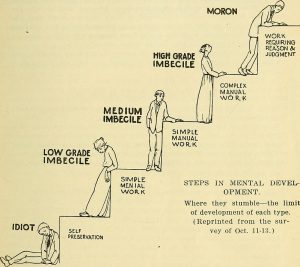
Upon entering any U.S. public school today, you will likely see evidence that learners with disabilities are present and included. You might see a student using a wheelchair or talking with peers using a voice output communication device. You might see adapted swings on the playground or calming sensory rooms as you walk down the halls. You might see students and staff creating sidewalk art on April 2 to advocate for autism acceptance or wearing wild socks on March 21 to raise awareness about Down Syndrome.
These signs of inclusion weren’t always present. In fact, the history of education in the United States is marked by practices that excluded, segregated, and marginalized people with disabilities based on the presumption that they were incompetent or incapable of benefitting from instruction. This presumption is demonstrated in this illustration, which depicts the expected limits of development for individuals with disabilities as described in a report to the Virginia General Assembly in 1915 (Virginia State Board of Charities and Corrections, 1915).

Because they were viewed as incapable and incompetent, individuals with clearly identifiable disabilities, such as significant intellectual disabilities or visible physical impairments, were often placed in institutions and residential facilities away from their families and communities well into the 20th century. This practice was described as a charitable and responsible way for society to protect them. This photograph depicts one such institution (Minnesota, 1893). This site was originally opened as the Minnesota Institute for Defectives in 1887 and was officially renamed the School for the Feeble-Minded in 1895 (Minnesota History Center, 2020). These images and the terms used in them are representative of practices and beliefs that existed to some degree well into the 20th century.
CRITICAL LENS: INSULTING LANGUAGE
When you look at some of the language used in the image above, you might see some overlaps with language used as insults (like calling someone an “idiot” or a “moron”). It is important to realize that these terms do have a long history of referring to people with special needs in negative ways. Learn more about which words have insulting histories[4], and check yourself when you use terms like “idiot,” “moron,” or “crazy” in your daily conversations. Watch this video to learn more about the “r word” and why it should be eliminated from your daily discourse.
Exclusionary practices continued into the 1970s when 1.75 million school-age children with disabilities were fully excluded from public schools and an additional three million children were placed in educational settings that did not meet their needs (Yell, 2019). These practices began to change in 1975 when the Education for All Handicapped Children Act (EAHCA) was passed. This law established a foundational set of protections for individuals with disabilities in U.S. public schools, which have since been expanded upon. These protections included the right to (a) a free education for all students between the ages of 3 and 18, (b) education in community schools when appropriate, (c) non-discriminatory evaluation to identify educational needs, (d) parent involvement in decision making, and (e) an individualized learning plan that defines appropriate goals and supports for each student with a disability (Yell, 2019).
Today, the educational rights of students with disabilities are protected by three major laws. These are Section 504 of the Rehabilitation Act (1973), the Individuals with Disabilities Education Improvement Act (2004; a reauthorization of EAHCA), and the Americans with Disabilities Act (ADA, 1990). These laws differ in how they define disability and in how they provide supports and protections.
Legal Protections for Students with Disabilities
The Rehabilitation Act established a very broad definition of disability in 1973, which was subsequently incorporated into the Americans with Disabilities Act (ADA) in 1990. Any individual who has an impairment that significantly impacts their ability to perform a major life function (such as walking, speaking, learning, or sitting) is defined as an individual with a disability and receives protection under these two laws (Rehabilitation Act, 1973). The Rehabilitation Act and ADA are civil rights laws that evolved from the Civil Rights Act of 1964 and extend the protections of educational access and equal opportunity to individuals with disabilities.

Broadly, the Rehabilitation Act addresses disability-related discrimination by any institution that receives public funding and Section 504 of the Rehabilitation Act specifically applies to schools, including institutions of higher education. The ADA provides protections in all public facilities other than churches and private clubs (Smith, 2001). Generally speaking, educators implement the protections of Section 504 of the Rehabilitation Act and the ADA by providing accommodations that allow students with disabilities to fully access curricular materials and physical spaces. In most cases, accommodations provided through Section 504 are specific to the needs of the individual student and are documented in a 504 plan. Examples include providing technology with speech-to-text features for a student with physical impairments that significantly impact writing or a chair with armrests for a student who needs additional support for core stability. Conversely in school settings, ADA supports are often proactively added to public spaces and materials to provide accessibility for all. Examples include closed captioning of videos, curb cuts, ramps or elevators, and fire alarms that provide both auditory and visual alerts.
In contrast to the Rehabilitation Act and ADA, the Individuals with Disabilities Education Improvement Act (IDEIA) has a much more specific definition of disability. An individual must have characteristics that align with one or more of 14 eligibility categories (referenced in Table 2.2) and those characteristics must have a negative impact on learning. A very specific evaluation process is used to determine if a student qualifies for services under the IDEIA.
Table 2.2: Categories of Disability under the Individuals with Disabilities Education Improvement Act
|
|
The IDEIA provides protections to students between the ages of 3 and 21, though the protections are discontinued when a student graduates from high school with a standard diploma. The law is focused on ensuring that students with disabilities receive a Free Appropriate Public Education (FAPE). This means that students must receive specially designed instruction, including special education and accommodations, that allows them to make meaningful progress toward the curriculum and their individual learning goals. All of these services must be provided at public expense. A unique learning plan for each student, called an Individualized Education Plan (IEP), must be developed annually by a team that includes general and special education teachers, administrators, the student’s parents, and the student (when age-appropriate). Additionally, the IEP must be implemented in the Least Restrictive Environment (LRE). The principle of LRE states that students with disabilities must be educated in the same setting as their peers who do not have disabilities, unless it is not possible for the student to make progress in that setting even when additional supports are added.
Critical Lens: IDEA or IDEIA? The Lingo of Special Education
In 1990, Congress reauthorized the Education for All Handicapped Children Act and renamed it the Individuals with Disabilities Education Act. The acronym IDEA quickly became embedded in the lingo of education, referencing the law itself and the “idea” that equal educational access for individuals with disabilities was becoming a valued part of our educational system. In 2004, Congress reauthorized the law again, providing some additional clarity and protections.They named this update the Individuals with Disabilities Education Improvement Act, making the official acronym IDEIA. Although IDEIA is the most technically correct abbreviation, educators still use the word “idea” when discussing the law.
Serving Students with Disabilities in the General Education Classroom
Teachers of all levels and subjects should expect to work with students who have disabilities. Data from the 2018 – 2019 school year show that 7.1 million students, approximately 14% of the total school-age population, receive special education under the IDEIA. Of those students, 82% spend at least 40% of their school day in a general education classroom (Institute of Education Sciences, 2020). Essentially, this means that most students who have disabilities are taught in the same setting and by the same teachers as learners who don’t have disabilities for large portions of the school day. Therefore, all teachers must be prepared to educate these students.
It is important for teachers to realize that special education is a service, not a place. This means that services including specialized instruction, accommodations, and modifications that address student needs can be provided in any setting and school teams are required to ensure that this happens in the Least Restrictive Environment (LRE). Both the IDEIA and Section 504 establish the general education classroom as the first consideration for LRE. Teams may only consider more restrictive settings, such as separate special education classrooms, when specialized supports added to the general education classroom are ineffective at meeting student needs.
In addition to supporting students with identified disabilities under IDEIA or Section 504, educators will also serve students whose disabilities may be unidentified. Because so many factors influence student development and learning, as discussed earlier in this chapter, it is critical that educators thoughtfully and systematically distinguish learning challenges caused by disabilities from learning challenges caused by social and environmental factors. When concerns develop about a student’s learning, general education teachers are expected to provide research-based interventions in an attempt to meet student needs and to collect progress monitoring data to support educational decision making. This process, often called Response to Intervention (RTI), is beneficial in that all students who demonstrate learning difficulties are systematically supported, regardless of whether they ultimately qualify for special education. Further, Response to Intervention (RTI) models have been shown to reduce misclassification of students with disabilities.
While teachers may feel challenged to meet the diverse and complex needs of students with disabilities in the general education classroom, the outcomes can be rewarding for students and teachers, alike. Benefits for students with disabilities include academic gains, improved social skills, and increased friendships (e.g., Wehmeyer et al., 2020). Peers who do not have disabilities have been shown to have deeper understandings of themselves, positive expectations of interactions with people with disabilities, and, in cases where peers act in support roles, greater academic engagement (e.g., Carter et al., 2015). Additionally, general education teachers have reported feeling more aware of and more effective at meeting the needs of all students after working with students with disabilities (Finke et al., 2009). These positive outcomes are linked to the use of strategies that provide a broad range of support for all students.
Universal Design for Learning
One framework that can be particularly beneficial to teachers in attempting to meet the needs of all learners is called Universal Design for Learning (UDL). The concept of universal design originated in architecture and is grounded in the idea that it is more efficient to build supports for accessibility into a structure from the beginning than to add supports after a structure has already been completed. In architecture, such supports benefit many people, not just those with disabilities. Consider, for example, how ramps help people pushing strollers or moving heavy items on carts, in addition to providing building accessibility to people using wheelchairs.
When carrying the principle of universal design from architecture into Universal Design for Learning (UDL), teachers develop lessons around three core concepts that support accessibility: engagement, representation, and expression (CAST, 2018).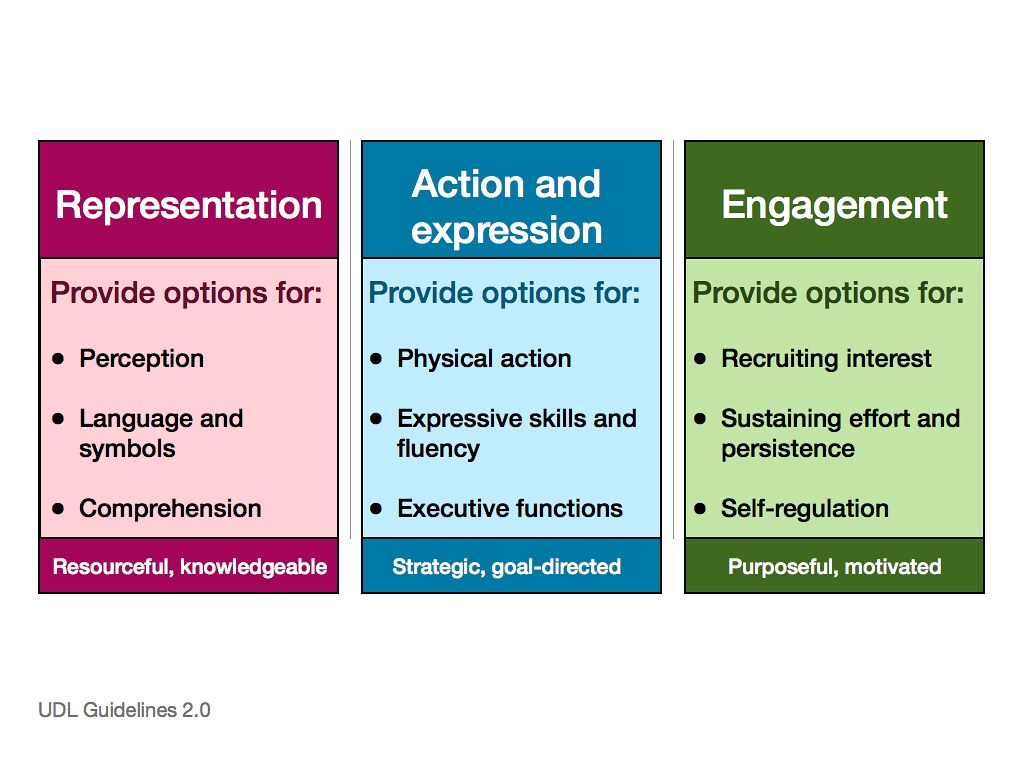
- Engagement refers to optimizing student interest. Strategies that support engagement include creating opportunities for student choice and designing learning activities that allow learners to connect classroom content to authentic local and global issues.
- Representation refers to the means by which content is presented. UDL lessons present content in multiple formats (e.g., text, images, song, spoken language, physical models) allowing students to engage a variety of senses. Additionally, effective teachers select representations of content that make new vocabulary clear and activate student background knowledge (CAST, 2018).
- The final component of UDL is expression. In strong UDL lessons, students have the opportunity to express their understanding of content using a variety of modalities (e.g., speaking, writing, building, creating).
Lessons that incorporate multiple means of engagement, representation, and expression have demonstrated benefit for diverse learners. Learn more about UDL in the video below, or by visiting the ThinkUDL podcast[5].
Accommodations & Modifications
Lessons built upon the principles of UDL will address the needs of many learners in a classroom. However, some students will need individualized support. Accommodations and modifications are individualized supports that may be provided to students with disabilities, English Language Learners, and students who are receiving other types of intervention.
An accommodation is a change to learning materials, the environment, or an assessment that does not fundamentally change the curriculum expectation or lower the standard of performance for the student. Clear examples of accommodations include seating a student away from distractions, providing enlarged print, or reading a history exam aloud. In each of these cases, students complete the same learning standards and activities as their peers. The accommodations are designed to reduce the impact of the individual’s disability or learning difference.
In contrast, a modification is a substantial alteration that reduces the complexity of the learning standard for a student. Modifications should be considered after all possible accommodations have been exhausted. The key to distinguishing an accommodation from a modification is understanding the grade-level learning objective. If the change alters the grade-level standard, it should be considered a modification. Examples include a student using a calculator to solve multiplication facts on a math test designed to assess the student’s knowledge of multiplication or when a student has to describe the characteristics of two planets while their classmates are expected to describe the characteristics of eight planets. Accommodations and modifications are both appropriate for students with disabilities at times. However, persistent use of modifications alters the curriculum that a student is exposed to and has long-term implications for grading and graduation.
It is important for teachers, parents, and students to discuss accommodations and modifications to make sure they are specifically selected to address each individual student’s strengths and needs. They should also be selected to maximize student independence and provide a realistic picture of student skill (Lai & Berkeley, 2012). Once selected, accommodations and modifications are clearly spelled out in IEPs and 504 plans for students with disabilities. They may be described in other types of learning plans, as well. It is important that teachers understand that accommodations and modifications are not optional. Once they are in an IEP, 504 plan, or any formal written plan, the teacher is legally obligated to provide them.
CRITICAL LENS BOX: ACCOMMODATIONS AND MODIFICATIONS
It is not uncommon for educators to be confused about the differences between accommodations and modifications. Many teachers and parents have also questioned the fairness of students who receive accommodations or modifications being on the A/B honor roll with their peers who do not receive those supports. It is sometimes helpful to think of these supports outside the realm of academics to get a better understanding of their implications. Remember that in order to determine if a support is an accommodation or modification, one must have an understanding of the standard of performance. Think for a minute about the “standards of performance” in a baseball game. What is a player expected to do? What skills does a baseball game assess? With those skills in mind consider these two images. The first image shows a left-handed pitcher using a glove designed to go on his right hand. Most baseball players are right-handed and use gloves designed for their left hands. The second image shows a very young baseball player using a tee ball stand to hit a ball. Most baseball players hit a ball that is pitched to them.

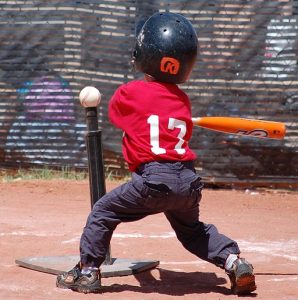
Both of these players are using a support that addresses an individual need. One of them could be described as using an accommodation. The other is clearly using a tool that modifies the standards of baseball.
In considering the implications of these supports, most would agree that the baseball player using a left-handers glove has achieved the same standards as his teammates and is therefore deserving of the same salary as other baseball players. However, the tee ball stand clearly does alter the standards of baseball and would be considered a modification to the game. It is a needed support for the young player, but should not afford him the same recognition (or salary) as a player who does not use the modification. The same principles would hold true for grades and academic tasks. A student using accommodations has completed the same standards as peers who do not use them and should be afforded the same recognition. Students who require modifications, should be granted those supports so they can make progress in their own time. However, the modifications must be documented in the student’s academic record to provide a clear picture of the student’s level of knowledge and skill. That does not mean, however, that a student participating in a modified curriculum should be excluded from the honor roll, or identified as different in recognition ceremonies. These types of activities were designed to recognize student effort and accomplishment, not to compare students.
Specialized Instruction Provided by Special Educators
In addition to high-quality instruction from general education teachers, students with disabilities served under the IDEIA also receive specialized instruction from a special education teacher. Specialized instruction refers to research-based intervention that is specifically designed to address areas of need that are linked to the student’s disability. These interventions differ from general education instruction in pace, intensity, and structure (Bateman & Bateman, 2014). They are also often delivered with a smaller pupil-teacher ratio. Specialized instruction can be delivered in the general education classroom. There are also times when an IEP team may determine that specialized instruction should be delivered in a special education setting.
Serving Students with Disabilities in Special Education Settings
There are some instances when the needs of a student with a disability cannot be fully addressed in the general education classroom. IEP teams may determine that a special education setting is the Least Restrictive Environment for some or all of a student’s school day. This may be because the intensity of the specialized instruction cannot be provided in a large group setting, because there are health or safety concerns, or out of respect for a student’s privacy. For example, an eighth grader who reads at a first grade level may be uncomfortable working on reading intervention in the general education language arts class and therefore receive reading intervention in a special education setting. The IEP team must document and provide a rationale for any time that a student is removed from the general education setting per IDEIA regulations.
Even when students with disabilities receive instruction in a special education classroom for some or all of their school day they still have a right to access the general education curriculum, engage in extracurricular activities, and socially engage with same-age peers. Truly inclusive schools make this a priority.
Critical Lens: Labels and Representation

As culturally responsive educators, we have a duty to speak with and about our students, families, and communities in respectful ways. We are currently experiencing a societal shift in understanding what this means, especially in relation to labels and representation of race/ethnicity, gender identity, and ability. We have recognized that individuals within various communities have a right to select the language and symbols that are used to represent them. Since 1990, educators have been taught to use person-first language when discussing disability. For example, we would say “a student with a learning disability,” rather than ”a learning disabled student.” This language was intended to reflect the idea that a person is not defined by any single characteristic, including their disability. While person-first language is generally considered the respectful standard when an individual’s preference is unknown, we now understand that many embrace identity-first language. This is particularly true in the Deaf community and for certain portions of the autism community. Identity-first language begins with the disability label (e.g., a Deaf woman, an autistic author), and is chosen by some individuals to indicate that the labeled characteristic is integral to their being. It is important that we listen to our students and their family members and follow their preferences for either person-first or identity-first language. Similarly, we must be mindful of preferences when choosing images that represent groups of people. The puzzle piece and color blue have long been associated with autism. There is a portion of the autism community that rejects these symbols as ableist representations, preferring either a rainbow-colored infinity symbol (as shown below) or multi-colored hexagon (as seen in the logo of the Autistic Self Advocacy Network). For more insight into perspectives on representing autism you may wish to visit The Autism Puzzle Piece: A Symbol That’s Going to Stay or Go?[6]
Looking Forward
We have come a long way from the days when individuals with disabilities were systematically excluded from or segregated in U.S. public schools. Many would say that the promise of the original Education of All Handicapped Children Act has been met. Today, every child has the right to a free appropriate public education in the least restrictive environment. There is still work to do, however. Our focus now is not just on allowing every child to have access to school buildings and content, but ensuring that every learner gets the support they need to make meaningful progress toward an independent and fulfilling life after graduation. We need to recognize and confront practices that stigmatize difference, set low expectations, and create disproportionately negative impacts on our diverse learners.
Table 2.3 lists additional resources that can support you as you advocate for your learners with special needs in your future classroom.
Table 2.3: Additional Resources for Special Education Topics
| Resource | Description |
| Virtual Museum of disAbility History
https://www.museumofdisability.org/virtual-museum/index.html |
This virtual museum provides images and documents reflecting the history of education, medicine, and advocacy for individuals with disabilities in the United States. |
| CAST | This site provides information about Universal Design for Learning. Resources include videos, tools for creating educational materials with UDL, and a database for exchanging lesson ideas and materials. |
| UDL Lesson Builder | This site provides exemplar lesson plans that incorporate elements of Universal Design for Learning. |
| A Day in Our Shoes
https://adayinourshoes.com/wp-content/uploads/IEP-Accommodations-and-Strategies-printable.pdf |
This site provides an extensive list of accommodations and modifications for consideration. |
| IRIS Center | This online interactive module explains how a Response to Intervention model can be used to determine the presence of a learning disability in an elementary-school aged student. |
Conclusion
In this chapter, we surveyed how student differences and similarities in various contexts influence their learning. Systems that influence students’ learning include Bronfenbrenner’s ecological systems theory, Maslow’s hierarchy of needs, and Gardner’s theory of multiple intelligences. Selected theoretical perspectives on development include Piaget’s cognitive developmental theory, Vygotsky’s sociocultural theory, Erikson’s psychosocial theory, and the information processing theory. Additionally, we studied how special groups of learners–English Learners (ELs) and students with special needs–bring unique strengths and challenges that significantly impact their learning environments.
As we saw in the Unlearning Box at the beginning of this chapter, all of our students bring different characteristics with them to our classrooms. While some (not all!) students may share certain characteristics and overall developmental trajectories, teachers must acknowledge that each student in the classroom has individual strengths and needs. Only once we know our students as individual learners will we be able to teach them effectively.
- https://www.tes.com/news/growth-mindset-where-did-it-go-wrong ↵
- https://www.doe.virginia.gov/instruction/esl/guidance.shtml ↵
- https://wida.wisc.edu/ ↵
- https://www.forbes.com/sites/andrewpulrang/2021/02/20/its-time-to-stop-even-casually-misusing-disability-words/?sh=15c02fd57d4e ↵
- https://thinkudl.org/ ↵
- https://the-art-of-autism.com/the-autism-puzzle-piece-a-symbol-of-what/ ↵
A theory of child development which outlines five levels of influence from a student’s environment: individual, microsystem, mesosystem, exosystem, and macrosystem.
Succession of 8 hierarchical needs, divided into deficiency needs (physiological, safety, belongingness & love, and esteem needs) and growth needs (need for knowledge & understanding, aesthetic needs, self actualization, and transcendence).
Framework designed by Benjamin Bloom and colleagues in 1956, and later revised in 2001. Divides educational goals/cognitive processes into six categories of increasing complexity: remember, understand, apply, analyze, evaluate, and create.
Theory created by Howard Gardner in 2004. The eight multiple intelligences include musical, bodily-kinesthetic, interpersonal, verbal-linguistic, logical-mathematical, naturalistic, intrapersonal, and visual-spatial.
Often associated with visual, auditory, reading/writing, and kinesthetic (VARK) input of information. In actuality, learning styles have no research-based support and are a myth.
Cognitive developmental theorist who identified four stages of cognitive development in children: sensorimotor, preoperational, concrete operational, and formal operational.
First stage in Piaget's cognitive development from ages birth to two in which young children learn about their world through their senses.
Second stage in Piaget's cognitive developmental theory in which children between the ages of 2 and 6 or 7 develop language, imagination, and memory, working toward symbolic thought.
Third stage of Piaget's theory of cognitive development in which children between the ages of 6 or 7 through 11 or 12 begin to think more logically and abstractly as they work toward operational thought.
Fourth stage in Piaget's theory of cognitive development in which children aged 11 or 12 through adulthood develop better reasoning and abstract thinking skills.
Realization that things continue to exist even if they are not in view. Developed during the sensorimotor stage of cognitive development, according to Piaget.
Understanding developed during the preoperational stage of Piaget's cognitive developmental theory that specific properties of objects remain the same even if other properties change.
Characteristic of the preoperational stage of Piaget's cognitive developmental theory in which children focus on only one aspect of a situation.
Worldview developed during the preoperational stage of Piaget's cognitive developmental theory that means children see the world from their own perspective and not other points of view.
Understanding developed during the concrete operational stage of Piaget's cognitive developmental theory that allows children to change direction in linear thinking to return to a starting point.
Understanding developed during the concrete operational stage of Piaget's cognitive developmental theory that allows children to infer relationships between two objects based on objects' relation to a third object in serial order.
Ability to monitor and think about your own thinking.
Ways in which we organize information as we confront new ideas.
In Piaget's cognitive developmental theory, a new experience that forces children to accommodate or assimilate existing schema.
In Piaget's theory of cognitive development, the balance achieved when schema align with experiences.
In Piaget's theory of cognitive development, use of existing schema to interpret new situations.
In Piaget's theory of cognitive development, changing schema to accommodate new information or experiences. In special education, a change to learning materials, the environment, or an assessment that does not fundamentally change the curriculum expectation or lower the standard of performance for the student.
Act of constructing understanding of the world through cognitive development. Piaget's concepts of schema, equilibrium, disequilibrium, assimilation, and accommodation are parts of cognitive constructivism.
Russian psychologist and sociocultural theorist who created the zone of proximal development.
Approach toward learning that centers social interactions as opportunities for constructing new knowledge. Vygotsky's sociocultural theory and zone of proximal development are examples of social constructivism.
According to Vygotsky, the difference between what a learner can do without help and what they can do with help.
According to Erikson's psychosocial theory, people go through eight developmental crises: trust vs. mistrust; autonomy vs. shame and doubt; initiative vs. guilt; industry vs. inferiority; identity vs. role confusion; intimacy vs. isolation; generativity vs. stagnation; and ego integrity vs. despair.
Identifies thinking and problem solving through three basic mental processes: (1) attending to sensory input in the sensory register; (2) encoding the attended information into short-term or working memory; and (3) retrieving information from long-term memory.
Students whose primary or home language is a language other than English. May also be called English Language Learners (ELLs).
Early terminology to refer to English Learners (ELs). Problematic in its deficit framing.
Students whose primary or home language is a language other than English. May also be called English Learners (ELs).
Abbreviation for English as a Second Language programs.
Abbreviation for English for Speakers of Other Languages programs.
Instructional approach that involves pre-teaching background knowledge or vocabulary necessary for upcoming instruction. Particularly helpful for ELs.
Consortium that designed standards for and assessments of assess English language skills for ELs.
Standards-based reform passed in 2001 as a reauthorization of the 1965 Elementary and Secondary Education Act. Increased educational accountability through standardized testing.
Component of No Child Left Behind that created English Language Proficiency Standards and introduced requirements for states to test English learners annually for oral, written, and reading proficiency in English.
1975 legislation that established a foundational set of protections for individuals with disabilities in U.S. public schools, including (a) a free education for all students between the ages of 3 and 18, (b) education in community schools when appropriate, (c) non-discriminatory evaluation to identify educational needs, (d) parent involvement in decision making, and (3) an individualized learning plan.
Passed in 1973 to prohibit discrimination based on disability. Includes Section 504.
Specific section of the 1973 Rehabilitation Act that forbids organizations (including schools) from excluding or denying services to individuals with disabilities. Individual student accommodations are documented in personalized 504 plans.
Pronounced "idea"; 2004 reauthorization of the Education for All Handicapped Children Act (EAHCA) that defines 14 specific disability categories. Also called IDEA.
Stipulation of IDEiA that students with special needs must receive specially designed instruction, including special education and accommodations, that allows them to make meaningful progress toward the curriculum and their individual learning goals. All of these services must be provided at public expense.
Unique learning plan for students with disabilities developed annually by a team that includes general and special education teachers, administrators, the student’s parents, and the student (when age-appropriate).
Expectation that students with disabilities must be educated in the same setting as their peers who do not have disabilities, unless it is not possible for the student to make progress in that setting even when additional supports are added.
Research-based interventions to meet student needs and to collect progress monitoring data to support educational decision making.
Framework for instructional design to meet the needs of all learners in which teachers develop lessons around three core concepts that support accessibility: engagement, representation, and expression.
In special education, a substantial alteration to a learning standard that reduces the complexity for a student.

